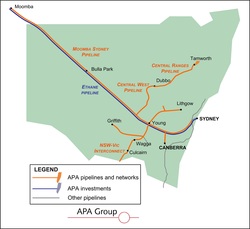 Unified government and industry rhetoric regarding a looming liquid natural gas (LNG) shortage has increased after the NSW government’s Energy Security Summit was held last week in Sydney. The pro-coal-and-gas message was loud and clear, while little to no mention was made of renewable options. NSW resources and energy minister Chris Hartcher said in his opening address, ‘Coal and gas contribute over 90 per cent of NSW’s energy needs,’ but, ‘still gives us the best opportunity to get back to energy security... Alternative sources of energy that could take the place of gas are not ready to come online.’ Adding to the pressure to drill is new coalition federal industry minister Ian Macfarlane, who told media last week the production of CSG in NSW is his number one priority. Meanwhile corporations are also ramping up against opposition to gas production; on their website, gas giant AGL threatened the pub- lic that: ‘Continuing to say “no” to natural gas development in NSW will have significant consequence for industry, manufacturers and households in that state.’ But is this just gold-plated rhetoric from fossil fuel companies eager to tap the lucrative overseas market? So far many of the talking points have not differentiated domestic and export markets, making the argument for expansion vague and potentially misleading. According to a report by the Australian Energy Regulator (AER), NSW is way behind in LNG projects compared to other states and is only supplying five per cent of its own supply. ‘Historical low-priced domestic gas contracts will progressively expire over the next five years. Contract replacement activity is expected to peak in QLD in 2015−16, and in NSW and Victoria in 2018... the expiration of low-priced contracts and their renegotiation in a market exposed to global prices will continue to place pressure on domestic prices.’ Demand for the state is not increasing However AER’s State of the energy market 2012 released last December also goes on to say that domestic demand for the state is not increasing. ‘Gas flows into NSW from July 2008 to July 2012 appear to be steady, that is no fluctuation.’ But a solution offered to protecting NSW from the expected 2018 gas price hike comes from NSW Greens MP Jeremy Buckingham. In a SMH opinion piece last week, he suggests the government, ‘regulate the gas market so that domestic gas demand is fulfilled before LNG exports are allowed.’ He added Western Australia has already implemented this. ‘Australians should not have to pay the price because these large gas companies have gambled in investing in LNG export terminals and export contracts before having secured a social licence or approvals to extract massive amounts of coal seam gas.’ The Echo asked Mr Hartcher’s office if Mr Buckingham’s suggestion would ensure energy security for the state and the reply was, ‘Given NSW produces just five per cent of its gas needs, Mr Buckingham would be wise to point out what gas in NSW is intended for the export market.’ When asked the same question, state MP for the seat of Ballina, Don Page, said that was a matter for the cabinet and he was not in a position to comment at this time. But Mr Page did claim much progress was being made in renewable energy. ‘Recently as acting minister for the environment I signed the contracts with AGL to build Australia’s biggest solar energy plants. ‘One is at Nyngan with a 102 megawatt capacity and the other near Broken Hill with a 53 megawatt capacity. ‘They will supply power to our grid by the end of 2015 for 50,000 homes. ‘The NSW government contributed $65m towards this project, which will create 450 jobs during construction. ‘Since 2011, 70,000 house- holds have installed solar power. ‘On CSG, the only sup- plier based in NSW is AGL which through their Camden gas project supplies five per cent of our NSW gas needs, the rest being imported from other states.’
0 Comments
Leave a Reply. |
Categories
All
Archives
November 2014
|
 RSS Feed
RSS Feed
